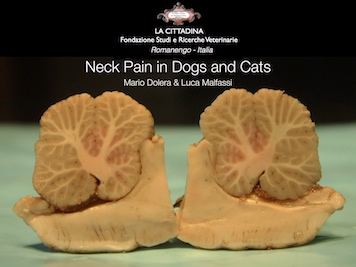NECK PAIN IN DOGS AND CATS
A retrospective study examined 178 animals referred between 2009 and 2012 for neck pain. The aim was to define the causes of neck pain in dogs and cats and to establish a diagnostic workup. Inclusion criteria were: the presence of neck pain at clinical examination, MRI and/or CT imaging of head, neck and chest, confirmed diagnosis based on cytology-histopathology or surgical findings or lab work, complete follow up. Lab works included blood cells count, biochemical profile and in selected cases cerebrospinal fluid (CSF) analysis or PCR tests. We considered: localization of lesions, type of pathology, primary or indirect involvement of Nervous System, neurological or systemic signs. Neurological pathologies were detected in 95% of patients whereas 5% were non-neurological. Lesions were localized in the neck in 72.5% of cases and in 17.4% both head and neck were involved. In 9% of cases the lesions were only in the head. Intervertebral degenerative disc disease was diagnosed in 52.5% of dogs, 19.5% were classified as neoplastic, 14.5% inflammatory, 8.5% traumatic, 2.5% malformative, 2.5% vascular. Regarding to the cats 66.6% were neoplastic, 22.2% traumatic, 11.2% inflammatory. In conclusion, lesions responsible for neck pain can localise in the neck, head or chest. Pain and lesion localization does not always correlate. There are differences in the prevalence and localization in dogs and cats. Based on the results, a complete diagnostic workup for animals with neck pain should include clinical examination, advanced imaging of the head, neck and chest. If appropriate, CSF analysis have to be performed.
